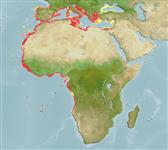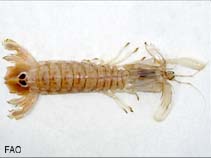Squilla mantis (Linnaeus, 1758)
Spottail mantis shrimp| Native range | All suitable habitat | Point map | Year 2050 |

|
| This map was computer-generated and has not yet been reviewed. |
| Squilla mantis AquaMaps Data sources: GBIF OBIS |
Классификация / Names народные названия | синонимы | CoL | ITIS | WoRMS
Malacostraca | Stomatopoda | Squillidae
Environment: milieu / climate zone / пределы глубины / distribution range экология
; пределы глубины 0 - 367 m (ссылка 365), usually 50 - 120 m (ссылка 436). Subtropical, preferred 20°C (ссылка 107945); 46°N - 17°S, 18°W - 36°E
Distribution страны | регионы FAO | Ecosystems | места находок | интродукции
Eastern Atlantic from Gulf of Cadiz, Canary, Madeira Island and south to Angola, and the Mediterranean Sea.
Length at first maturity / Size / Weight / Возраст
половая зрелость: Lm 8.7, range 2 - 2.4 cm Max length : 20.0 cm TL самец/пол неопределен; (ссылка 365)
Краткое описание морфология
Life cycle and mating behavior половая зрелость | размножение | нерест | Eggs | Fecundity | Larvae
Основная ссылка
ссылки | координатор | соавторы
Holthuis, L.B. 1987 Stomatopodes. p. 180 - 187. In Fischer, W., M. L. Bauchot and M. Schneider. 1987. Fiches FAO d' identification des espèces pour les besoins de la pêche. (Revision 1). Méditerranée et mer Noire. Zone de pêche 37. Volume I. Végëtaux et Invertébrés. Publication préparée par la FAO, résultant d'un accord entre la FAO et la Commission des Communautés européennes (Project GCP/INT/422/EEC) financëe conjointement par ces deux organisations. Rome, FAO, Vol.1. (ссылка 365)
Статус Красного Списка МСОП
(ссылка 130435: Version 2025-1)
Статус СИТЕС (ссылка 108899)
CMS (ссылка 116361)
Угроза для людей
Использование человеком
рыболовство: коммерческий; объект спортивного рыболовства: да
FAO - рыболовство: landings | FishSource | Sea Around Us
инструменты
дополнительная информация
ресурсы в Интернет
BHL | BOLD Systems | CISTI | DiscoverLife | FAO(рыболовство: ; publication : search) | Fishipedia | GenBank (Геном, Нуклеотид) | GloBI | Gomexsi | Google Books | Google Scholar | Google | PubMed | Tree of Life | Wikipedia (Вперёд, поиск) | Zoological Record



